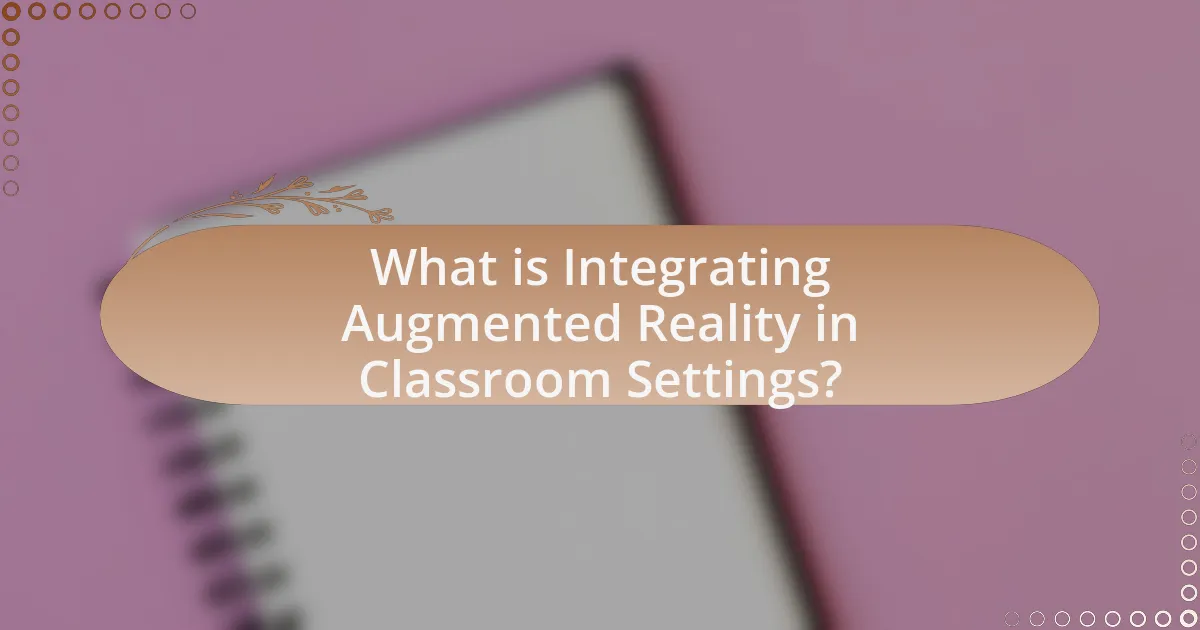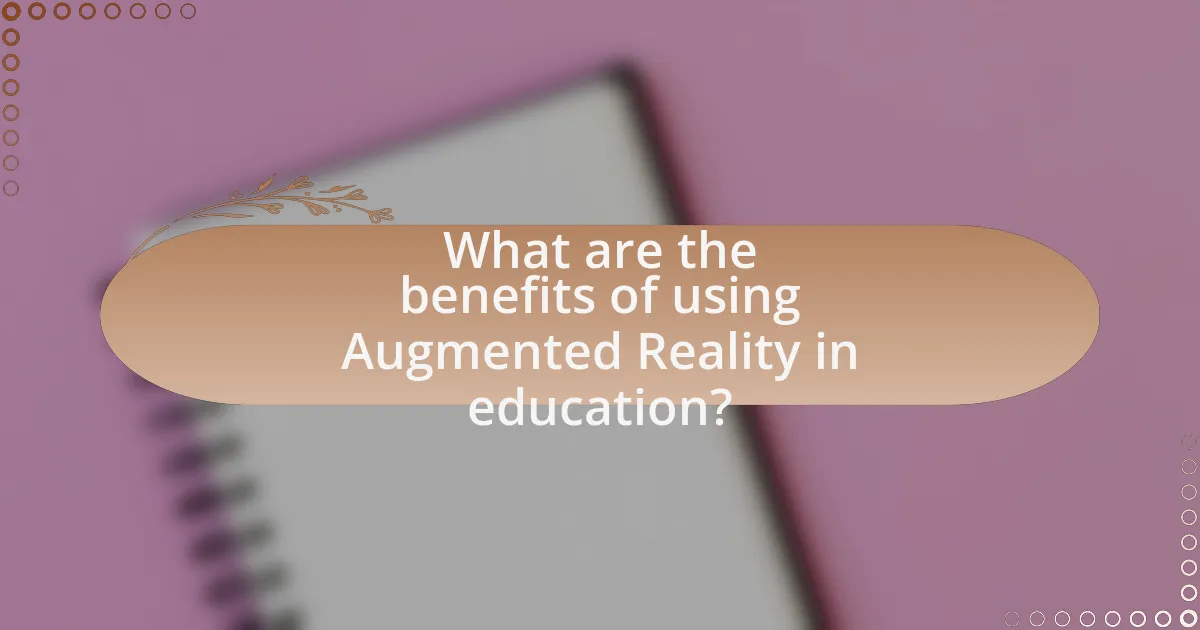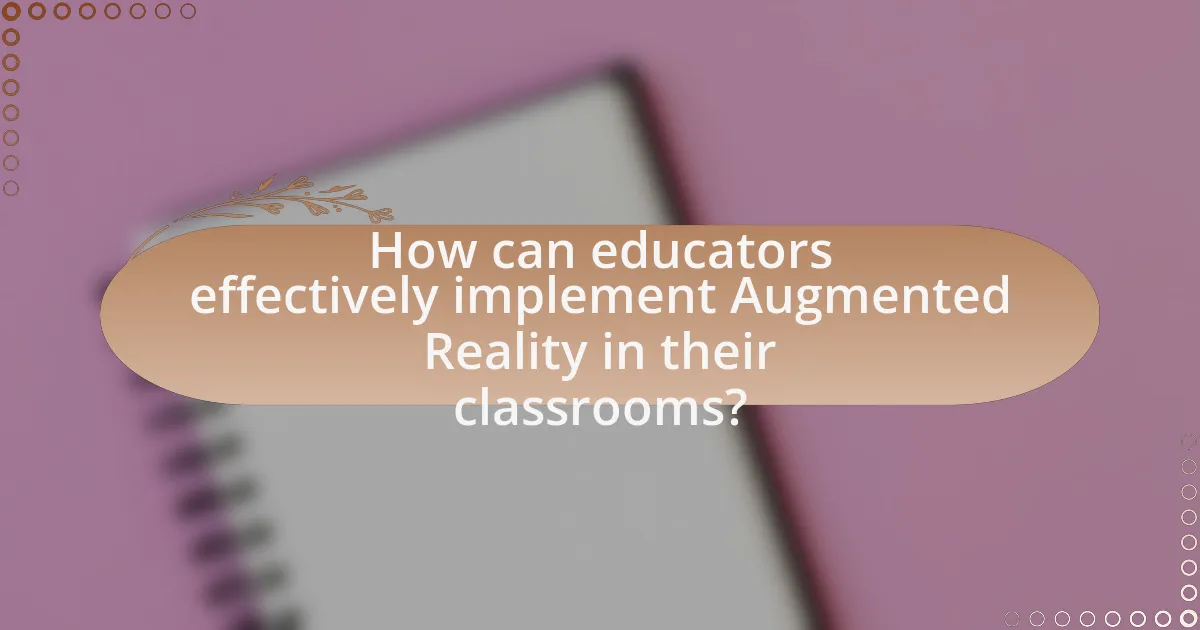Integrating Augmented Reality (AR) in classroom settings enhances the educational experience by overlaying digital information onto the physical environment, allowing students to interact with 3D models and simulations. This technology improves engagement, retention, and understanding of complex subjects, catering to various learning styles. Key features of AR in education include interactive learning experiences, real-time feedback, and collaboration among students. However, challenges such as high costs, technical issues, and the need for teacher training must be addressed for successful implementation. The article explores the benefits of AR, effective strategies for integration, and best practices for educators to maximize its impact on student learning.

What is Integrating Augmented Reality in Classroom Settings?
Integrating Augmented Reality in classroom settings involves the use of AR technology to enhance the educational experience by overlaying digital information onto the physical environment. This integration allows students to interact with 3D models, simulations, and visualizations that complement traditional learning methods, thereby improving engagement and understanding of complex subjects. Research indicates that AR can lead to increased retention rates and motivation among students, as evidenced by a study published in the Journal of Educational Technology & Society, which found that students using AR tools scored significantly higher on assessments compared to those using conventional teaching methods.
How does Augmented Reality enhance the learning experience?
Augmented Reality enhances the learning experience by providing interactive and immersive educational content that engages students more effectively than traditional methods. This technology allows learners to visualize complex concepts in real-time, facilitating better understanding and retention of information. For instance, a study published in the journal “Computers & Education” by Wu et al. (2013) demonstrated that students using AR applications scored significantly higher on assessments compared to those using conventional learning tools. This improvement is attributed to AR’s ability to create a dynamic learning environment where students can interact with 3D models and simulations, making abstract ideas more tangible and relatable.
What are the key features of Augmented Reality in education?
The key features of Augmented Reality (AR) in education include interactive learning experiences, enhanced engagement, and real-time feedback. AR allows students to visualize complex concepts through 3D models, making abstract ideas more tangible. For instance, studies show that students using AR applications demonstrate improved retention rates, with a reported increase of up to 70% in knowledge retention compared to traditional methods. Additionally, AR fosters collaboration among students by enabling shared experiences and problem-solving activities, which enhances social learning. Furthermore, AR provides immediate feedback, allowing educators to assess student understanding and adjust instruction accordingly.
How does Augmented Reality cater to different learning styles?
Augmented Reality (AR) caters to different learning styles by providing interactive and immersive experiences that engage visual, auditory, and kinesthetic learners. For visual learners, AR enhances understanding through 3D visualizations and simulations, allowing them to see complex concepts in a tangible way. Auditory learners benefit from AR applications that incorporate sound elements, such as narrated instructions or discussions, which reinforce learning through listening. Kinesthetic learners are engaged through hands-on activities facilitated by AR, enabling them to manipulate virtual objects and participate in experiential learning. Research indicates that AR can improve retention and understanding across various learning styles, as evidenced by a study published in the Journal of Educational Technology & Society, which found that students using AR showed a 30% increase in knowledge retention compared to traditional methods.
What are the potential challenges of integrating Augmented Reality in classrooms?
The potential challenges of integrating Augmented Reality (AR) in classrooms include high costs, technical issues, and the need for teacher training. High costs arise from the expense of AR devices and software, which can strain school budgets. Technical issues, such as software compatibility and hardware malfunctions, can disrupt lessons and hinder effective learning. Additionally, teachers may require extensive training to effectively implement AR tools in their teaching practices, which can be time-consuming and resource-intensive. These challenges can impede the successful adoption of AR in educational settings.
What technical requirements are necessary for successful implementation?
Successful implementation of augmented reality in classroom settings requires robust hardware, reliable software, and a stable internet connection. Hardware includes devices such as tablets or smartphones with sufficient processing power and graphics capabilities to run AR applications effectively. Software must be compatible with the chosen AR platforms and include educational content tailored for classroom use. A stable internet connection is essential for accessing cloud-based resources and facilitating real-time interactions. These technical requirements ensure that the AR experience is seamless, engaging, and educational for students.
How can educators overcome resistance to new technology?
Educators can overcome resistance to new technology by providing comprehensive training and demonstrating the practical benefits of the technology. Research indicates that when educators receive targeted professional development, they are more likely to adopt new tools effectively. For instance, a study by Ertmer and Ottenbreit-Leftwich (2010) found that teachers who participated in ongoing training reported increased confidence and willingness to integrate technology into their teaching practices. Additionally, showcasing successful case studies where augmented reality has enhanced student engagement and learning outcomes can further alleviate concerns and encourage adoption.

What are the benefits of using Augmented Reality in education?
The benefits of using Augmented Reality (AR) in education include enhanced engagement, improved retention of information, and the ability to visualize complex concepts. AR technology allows students to interact with 3D models and simulations, making learning more immersive and stimulating. Research indicates that students using AR in educational settings show a 30% increase in retention rates compared to traditional learning methods, as reported in a study by Wu et al. (2013) in the journal “Educational Technology & Society.” This interactive approach not only fosters a deeper understanding of the subject matter but also caters to various learning styles, thereby accommodating a diverse student population.
How does Augmented Reality improve student engagement?
Augmented Reality (AR) improves student engagement by providing interactive and immersive learning experiences that capture students’ attention. Research indicates that AR can enhance understanding of complex subjects by allowing students to visualize and manipulate 3D models in real-time, which fosters active participation. For instance, a study published in the journal “Computers & Education” by Wu, Lee, Chang, and Liang found that students using AR technology showed a 30% increase in motivation and engagement compared to traditional learning methods. This increased engagement is attributed to AR’s ability to create a more dynamic and participatory classroom environment.
What evidence supports the effectiveness of Augmented Reality in learning?
Augmented Reality (AR) has been shown to enhance learning outcomes significantly. Research indicates that AR can improve student engagement, retention, and understanding of complex concepts. For instance, a study by Wu et al. (2013) published in the journal “Computers & Education” found that students using AR technology scored 20% higher on assessments compared to those using traditional learning methods. Additionally, a meta-analysis by Cheng and Tsai (2019) in “Educational Technology & Society” reported that AR applications lead to increased motivation and active learning, with 85% of participants expressing a preference for AR-enhanced lessons over conventional approaches. These findings collectively support the effectiveness of AR in educational settings.
How can Augmented Reality facilitate collaborative learning?
Augmented Reality (AR) facilitates collaborative learning by enabling interactive and immersive experiences that enhance group engagement and understanding. AR allows multiple users to interact with digital content in a shared physical space, fostering teamwork and communication. For instance, studies have shown that AR applications in educational settings can improve students’ collaborative skills by providing real-time feedback and visualizations that support joint problem-solving activities. Research conducted by Wu et al. (2013) in “Augmented Reality in Education: A Review of the Research” highlights that AR promotes active participation and enhances the learning experience by allowing students to visualize complex concepts together, thus reinforcing collaborative learning outcomes.
What subjects or topics benefit most from Augmented Reality integration?
Subjects that benefit most from Augmented Reality (AR) integration include science, mathematics, history, and art. In science education, AR enhances understanding of complex concepts, such as anatomy or molecular structures, by providing interactive 3D visualizations. Mathematics benefits from AR by allowing students to visualize geometric shapes and solve problems in a spatial context. History lessons become more engaging through AR by bringing historical events and figures to life, enabling immersive experiences. In art education, AR facilitates creative expression by allowing students to interact with digital art in real-world environments. These applications are supported by studies showing improved engagement and retention rates among students when AR is utilized in these subjects.
How can Augmented Reality be applied in STEM education?
Augmented Reality (AR) can be applied in STEM education by providing interactive and immersive learning experiences that enhance student engagement and understanding of complex concepts. For instance, AR can visualize abstract scientific phenomena, such as molecular structures or astronomical events, allowing students to manipulate and explore these concepts in a three-dimensional space. Research conducted by Wu et al. (2013) in “Augmented Reality in Education: A Review of the Literature” highlights that AR applications in STEM classrooms significantly improve students’ spatial reasoning and problem-solving skills, leading to better academic performance.
What role does Augmented Reality play in language learning?
Augmented Reality (AR) enhances language learning by providing immersive and interactive experiences that facilitate engagement and comprehension. AR applications allow learners to visualize vocabulary and grammar in real-world contexts, making abstract concepts more tangible. For instance, studies have shown that using AR in language education can improve vocabulary retention by up to 30% compared to traditional methods, as learners interact with digital overlays that contextualize language use. This technology also promotes active participation, allowing students to practice speaking and listening skills in simulated environments that mimic real-life situations.

How can educators effectively implement Augmented Reality in their classrooms?
Educators can effectively implement Augmented Reality (AR) in their classrooms by integrating AR applications that enhance interactive learning experiences. For instance, using AR tools like Google Expeditions allows students to explore 3D models of historical sites or biological structures, fostering engagement and deeper understanding. Research indicates that AR can improve learning outcomes; a study published in the Journal of Educational Technology & Society found that students using AR scored significantly higher on assessments compared to those using traditional methods. By selecting appropriate AR content aligned with curriculum goals and providing training for both teachers and students, educators can maximize the benefits of AR in enhancing educational experiences.
What are the best practices for integrating Augmented Reality into lesson plans?
The best practices for integrating Augmented Reality (AR) into lesson plans include aligning AR experiences with learning objectives, ensuring accessibility for all students, and providing adequate training for educators. Aligning AR with specific learning goals enhances engagement and comprehension, as evidenced by studies showing that AR can improve retention rates by up to 70%. Ensuring accessibility involves selecting AR tools that accommodate diverse learning needs, which is crucial for inclusivity. Additionally, training educators on how to effectively implement AR technology is essential; research indicates that teachers who receive proper training are 50% more likely to successfully integrate new technologies into their teaching practices.
How can teachers assess the impact of Augmented Reality on student learning?
Teachers can assess the impact of Augmented Reality (AR) on student learning through a combination of qualitative and quantitative methods. These methods include pre- and post-assessments to measure knowledge gains, observational studies to evaluate student engagement and interaction with AR content, and surveys to gather student feedback on their learning experiences. Research indicates that AR can enhance understanding of complex subjects; for instance, a study by Wu et al. (2013) found that students using AR technology showed a 30% improvement in retention rates compared to traditional learning methods. By employing these assessment strategies, teachers can effectively gauge the educational benefits of AR in their classrooms.
What resources are available for educators to learn about Augmented Reality?
Educators can access various resources to learn about Augmented Reality (AR), including online courses, webinars, and educational platforms. Websites like Coursera and edX offer courses specifically focused on AR technology and its applications in education, often created by reputable institutions such as Stanford University and the University of London. Additionally, organizations like the International Society for Technology in Education (ISTE) provide webinars and articles that explore AR integration in classroom settings. Furthermore, books such as “Augmented Reality in Education: A New Approach to Learning” by Vladimir Geroimenko offer in-depth insights into practical applications of AR in teaching. These resources collectively equip educators with the knowledge and skills necessary to effectively implement AR in their classrooms.
What are some common pitfalls to avoid when using Augmented Reality in education?
Common pitfalls to avoid when using Augmented Reality in education include over-reliance on technology, lack of clear educational objectives, and insufficient teacher training. Over-reliance on technology can lead to distractions, as students may focus more on the AR experience than the learning content. Lack of clear educational objectives can result in AR activities that do not align with curriculum goals, diminishing their effectiveness. Insufficient teacher training can hinder the successful integration of AR tools, as educators may struggle to facilitate AR experiences effectively. Research indicates that effective implementation of AR in education requires careful planning and support to maximize its potential benefits.
How can educators ensure that Augmented Reality aligns with curriculum standards?
Educators can ensure that Augmented Reality (AR) aligns with curriculum standards by conducting a thorough analysis of both the AR content and the specific curriculum requirements. This involves mapping AR experiences to learning objectives outlined in educational standards, such as the Common Core State Standards or Next Generation Science Standards. For instance, if a curriculum emphasizes critical thinking and problem-solving, educators should select AR applications that foster these skills through interactive simulations or real-world problem scenarios. Additionally, educators can collaborate with curriculum developers and AR content creators to ensure that the technology supports pedagogical goals and meets assessment criteria. This alignment process is crucial, as studies show that technology integration is most effective when it directly supports established educational frameworks.
What strategies can be employed to maintain student focus during AR activities?
To maintain student focus during augmented reality (AR) activities, educators can implement structured tasks, clear objectives, and interactive elements. Structured tasks provide a framework that guides students through the AR experience, ensuring they remain engaged with the content. Clear objectives help students understand the purpose of the activity, which increases their motivation to participate. Interactive elements, such as quizzes or collaborative projects, encourage active participation and sustain attention. Research indicates that when students are actively involved in their learning process, their focus and retention improve significantly, as shown in studies on active learning methodologies.
What practical tips can educators follow for successful Augmented Reality integration?
Educators can successfully integrate Augmented Reality (AR) by starting with clear learning objectives that align with curriculum standards. This ensures that AR applications enhance educational outcomes rather than distract from them. Additionally, educators should select user-friendly AR tools that require minimal technical expertise, facilitating smoother implementation. Training sessions for both educators and students on how to effectively use AR technology can further enhance engagement and understanding.
Moreover, incorporating AR into collaborative projects encourages teamwork and communication among students, fostering a deeper learning experience. Regularly assessing the effectiveness of AR activities through student feedback and performance metrics allows educators to refine their approach and maximize the benefits of AR in the classroom. Research indicates that AR can improve student motivation and retention of information, making it a valuable tool in modern education.